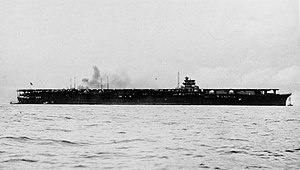Shōkaku-class aircraft carrier
This article needs additional citations for verification. (August 2009) |
 Shōkaku, 1941
| |
| Class overview | |
|---|---|
| Operators | |
| Completed | 2 |
| Lost | 2 |
| General characteristics | |
| Type | Aircraft carrier |
| Displacement | list error: <br /> list (help) 25,675 long tons (26,087 t) (standard) 32,000 long tons (33,000 t) (full load) |
| Length | 257.5 m (844 ft 10 in) |
| Beam | 26 m (85 ft 4 in) |
| Draft | 8.9 m (29 ft 2 in) |
| Installed power | 160,000 shp (120,000 kW) |
| Propulsion | list error: <br /> list (help) 4 × Kanpon geared steam turbines 8 × boilers 4 × shafts |
| Speed | 34.5 knots (63.9 km/h; 39.7 mph) |
| Range | 7,581 nmi (14,040 km; 8,724 mi) at 18 knots (33 km/h; 21 mph) |
| Complement | 1,660 |
| Armament | list error: <br /> list (help) 16 × 127 mm (5 in) dual purpose guns 36-96 × 25 mm (1 in) Type 96 anti-aircraft guns |
| Aircraft carried | list error: <br /> list (help) 72 (+12) 18 × Mitsubishi A6M Zeros 27 Aichi D3A1 "Val"s 27 Nakajima B5N1(2) "Kate"s |
The Shōkaku class (翔鶴型, Shōkaku-gata) was a pair of aircraft carriers of the Imperial Japanese Navy built before World War II. Only two vessels were built in this class; Shōkaku and Zuikaku. Together, they formed the 5th Carrier Division. Both were lost in action during World War II.
Design
The Shōkaku class carriers were part of the same program that also included the Yamato-class battleships. No longer restricted by the provisions of the Washington Naval Treaty, which expired in December 1936, the Imperial Japanese Navy was free to incorporate all those features they deemed most desirable in an aircraft carrier, namely high speed, a long radius of action, heavy protection and a large aircraft capacity.
With an efficient modern design, a displacement of about 32,000 long tons (33,000 t), and a top speed of 34 kn (63 km/h; 39 mph), the Shōkaku class could carry 70-80 aircraft. Their enhanced protection compared favorably to that of contemporary Allied aircraft carriers and enabled Shōkaku to survive serious battle damage during Coral Sea and Santa Cruz.[1]
References
- ^ Stille, p.17
Stille, Mark. Imperial Japanese Navy Aircraft Carriers 1921-45. Osprey Publishing, 2005. ISBN 1-84176-853-7.
